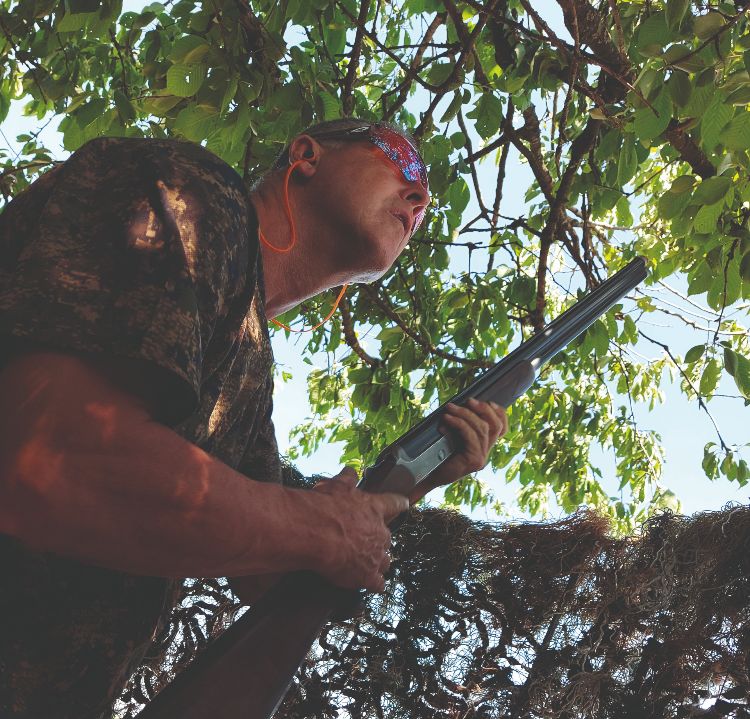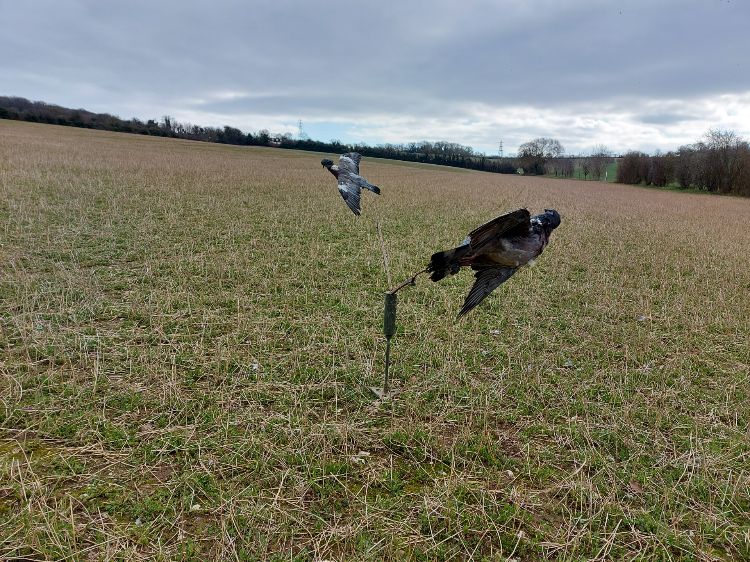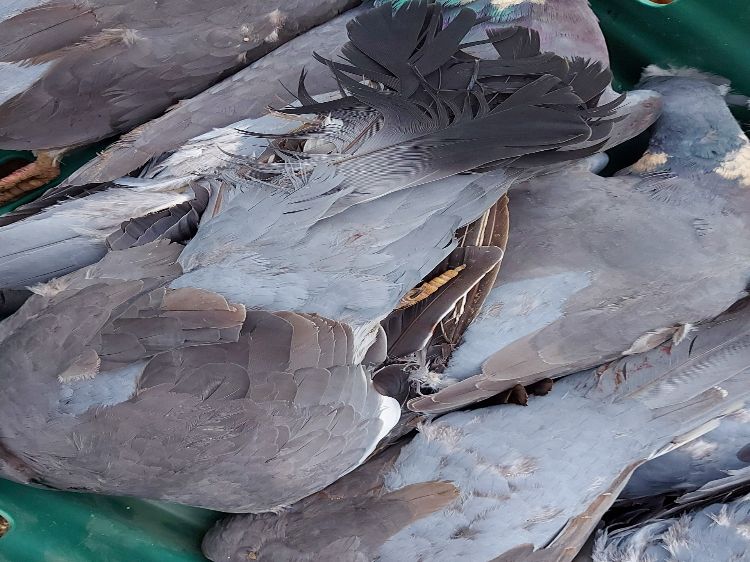Like all aspects of our sport, pigeon shooting has evolved over the years, with everything from the kit we use to the crops they favour undergoing some form of change. Many of us will be aware of, or have personally experienced, the changes that have shaped the game shooting world – from the introduction and gradual domination of the over-and-under, to the increase in imported game birds, and most recently the phasing out of lead shot… nothing in our industry stands still for long, despite our collective predisposition to maintaining tradition!
This month, we thought we would have a good chat with Mr Crow and find out first-hand how pigeon shooting has changed in the decades since his very first forays in the hide under the watchful eye of his grandfather.
 Kit
Kit
“Like lots of lads back in the day, and now I expect, I started shooting pigeons with a single barrel .410. I was introduced to pigeon shooting by my grandad and this is the gun I would shoot when in the hide with him. After a while, I moved on to a side-by-side 16-bore which I used for about a year, before it started playing up; it wasn’t the most reliable gun, which is why my grandad made me shoot it rather than him!
After that, I then moved on to a pump-action Savage 20-bore, followed by an SKB (Japanese gun) which I shot for a short period before I moved onto a Beretta 303 semi-auto. I used that Beretta for the bulk of my pigeon shooting for many years, and then the Hungerford massacre happened, and semi-autos with more than three shots (along with hand guns, actually) were banned. I took that prompt to switch to an over-and-under, only getting back behind a semi-auto several years later when things had calmed back down a bit. I used semi-autos for about 20 years after that.
Now, I use a Blaser F16 over-and-under, which is a great gun that I’ve shot for a few years now… it’s nice that I can use the same gun for pigeons and for game shooting, which I do a lot more of now than I used to. It means I don’t have to get my eye in with a different gun when the season comes around.
 In terms of decoys, flappers and whirlies… there was a lot less choice when I was a youngster! Growing up shooting pigeons with my grandad, most of our decoys were home-made. It was home-made or real birds, which we always preferred but which were not always available. We would make decoys out of drainpipes, cutting them up and painting them to look like birds. In those days, there weren’t so many people shooting, and the birds were a lot less wary and easier to decoy, so our home-made creations did the job! Now, the modern selection of ultra-realistic decoys is a godsend as the birds are generally more educated and wary. I use Sillosocks as they’re so light and convenient.
In terms of decoys, flappers and whirlies… there was a lot less choice when I was a youngster! Growing up shooting pigeons with my grandad, most of our decoys were home-made. It was home-made or real birds, which we always preferred but which were not always available. We would make decoys out of drainpipes, cutting them up and painting them to look like birds. In those days, there weren’t so many people shooting, and the birds were a lot less wary and easier to decoy, so our home-made creations did the job! Now, the modern selection of ultra-realistic decoys is a godsend as the birds are generally more educated and wary. I use Sillosocks as they’re so light and convenient.
We also used to make our own cradles too, and being a blacksmith, my grandad managed to make a flapper for us that worked a treat. I used to sit in the hide pulling on the string to make it flap! We also had a decoy that we would reel up in the tree using a fishing line pulley system; when we tripped the line, it would sail out of the tree and down onto the field, like it was landing. Once it’d landed and we’d (hopefully) taken the shot, we could reel it back up again and reset it.
It was a bit of faffing around, but it worked brilliantly, and in those days there was no such thing as electric flappers and rotaries. When rotaries did first come out, they were quite expensive, but it was still a huge game changer – the pigeons weren’t used to it, and it made poor pigeon shooters into good pigeon shooters as you didn’t need the fieldcraft anymore, you could just set up anywhere in the field, set the rotary off, and the birds would come into it from wherever they were heading! Now, they’re much more used to them and will sometimes associate the movement with danger. They’re pretty clever birds!”
 Numbers of birds
Numbers of birds
“People say all the time that there are fewer birds about than there used to be. I beg to differ on that one! I’d say there’s either similar numbers, or even slightly more around now, certainly where I farm anyway. With the way cartridge prices and the cost of living is going now, I can see less and less people being able to carry on with their shooting, meaning those numbers will potentially climb even higher.”
Crops
“When I was young, the fields were sown with machines that didn’t put the seed into the ground quite as well as the modern machines do. This meant there would be much more grain left on the top after sowing. In those days, the birds would get on a field and there’d be enough food available to keep them on it for up to about five days! It made it easier to plan your shooting, as you knew you could spot them on a field and they’d still be there a few days later.
These days, they get on a field and they can often clear it in a day, because the machines are so efficient that there is hardly anything left on the top after drilling. It means you get a lot less pigeon shooting on drillings than you ever used to. Machinery is so clever now, it’s all designed to maximise getting the crop in the combine and leaving less on the floor.
Crop varieties have also changed over time; they have been grown to be shorter and stiffer, with more growth regulator, and this means the crops don’t go flat as often as they used to. When the crop gets flattened, the birds used to flock to it as they could eat the grain off the floor rather than trying to land on the long, wavy standing crops. Now, the birds are now starting to perfect the art of landing on the shorter, stiffer crops we grow, so you can get some good shooting on that but remember it makes retrieving the birds much more difficult.”
Popularity
“There are definitely more people involved in pigeon shooting now than when I first started, but as mentioned earlier I do expect to see that dwindle a little with the rising costs. It’s good that more people are involved because it helps keep the numbers down for the farmers, however, the birds do get more wary the more people shoot at them (if they miss, anyway!). They become more educated and associate a bang with danger, which makes them much harder to decoy and shoot than they used to be. People knew what they were doing a bit more in those days.”
 Value of birds
Value of birds
“In the late 70s I can remember we’d get anywhere between 15 and 50p per bird, and cartridges at the time were about £60 per thousand, meaning you could make a nice little profit if you had a good day. The heyday was always around December, because the French wanted them for the Christmas period. The price would reach a peak.
Nowadays, the price is anywhere between 30 and 40p per cartridge. You can get up to about 75p a bird if you shoot with steel and are selling to the hawk men to feed their birds of prey, or to a zoo; but you expect more in the region of 20 to 35p if you’re selling direct to the game dealer.”
Andy's kit bag
Gun: Blaser F16 12-bore
Decoys & nets: UK Shoot Warehouse (Sillosocks)
Cartridges: Gamebore Clear Pigeon